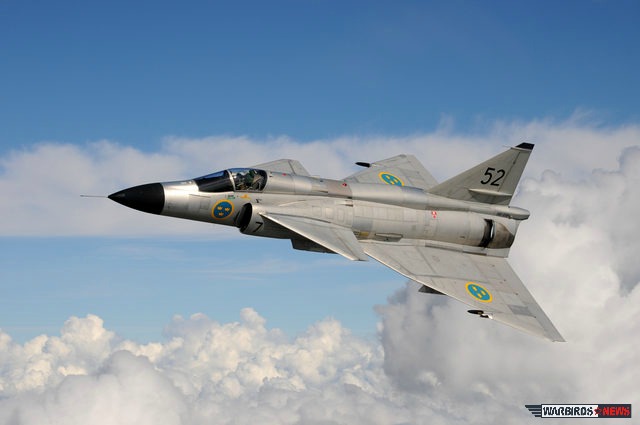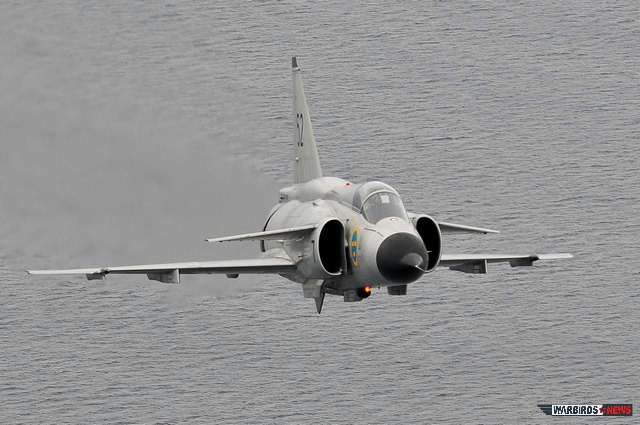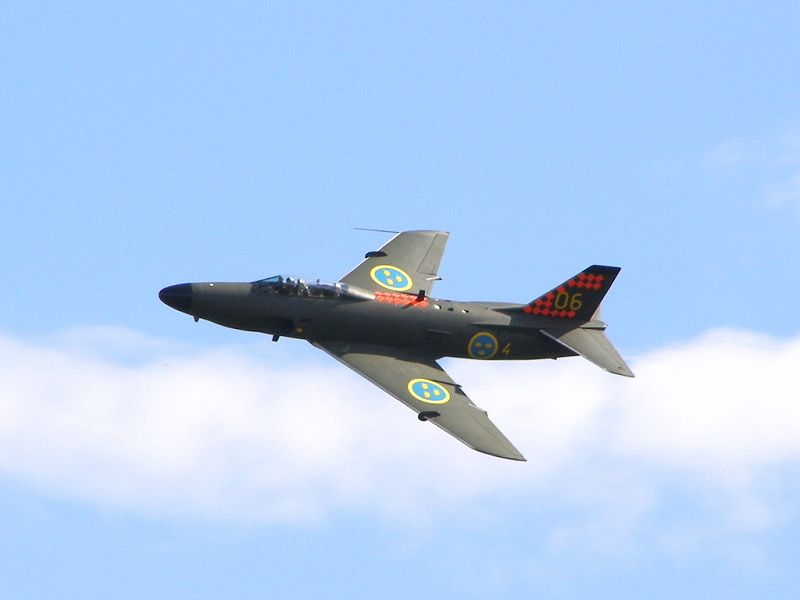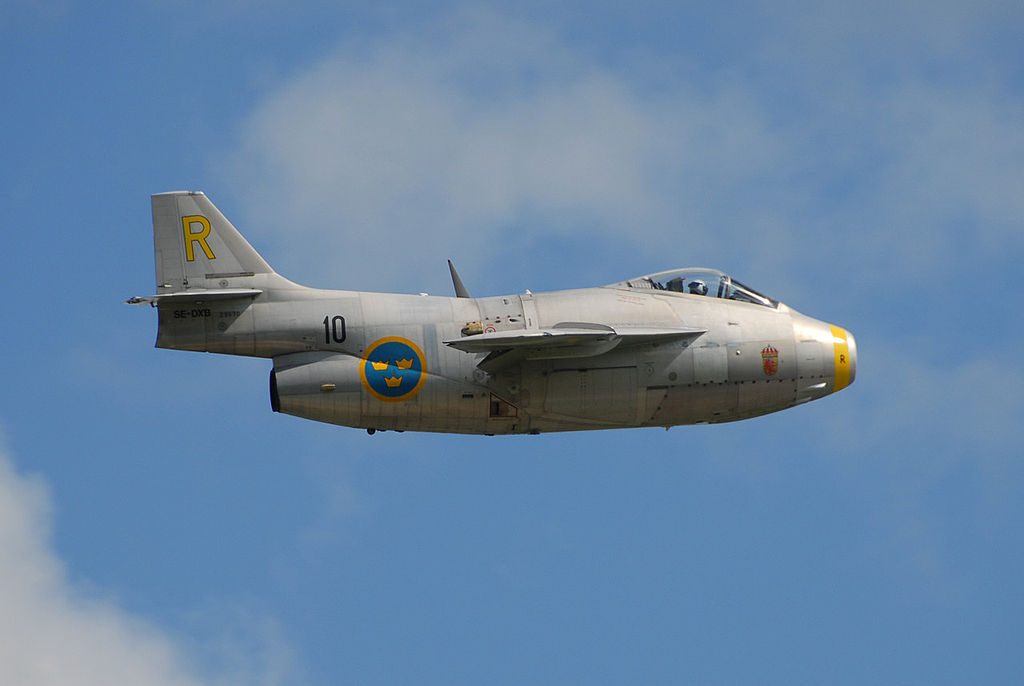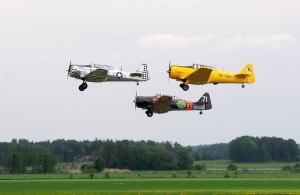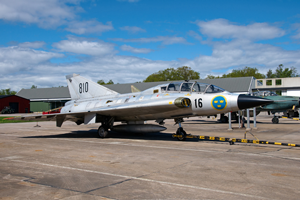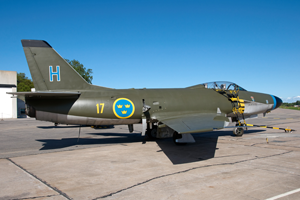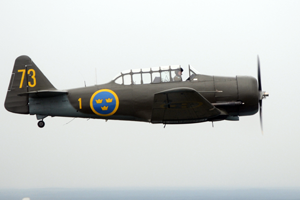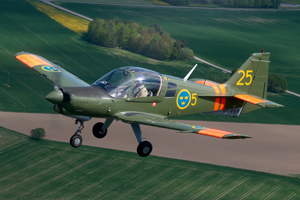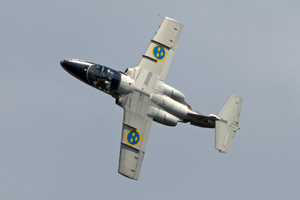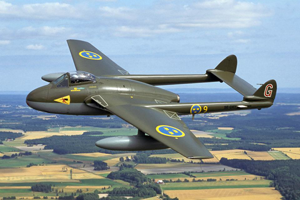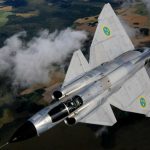In a relatively short time, the Swedish Air Force Historic Flight (SwAFHF) has built an impressive collection of airworthy warbirds, documenting the proud history of Flygvapnet, the Swedish Air Force. Though a relatively small country and officially neutral through both World Wars and into the Cold War, throughout the 20th Century Sweden inhabited a very dangerous neighborhood indeed. Unlike most countries their size, the Swedes were able to rely on their domestic aviation industry, Saab most particularly, to produce world-class fighter jets in those years when they once again found themselves sandwiched between the front lines of a global conflict. The SwAFHF has become the caretaker organization for airworthy examples of the most important aircraft that defended Mother Svea during the tense years of the Cold War and given Sweden’s unique aviation heritage, is often preserving warbirds that aren’t often seen anywhere else.
Luigino Caliaro reports:
(Image Credit: Luigino Caliaro)
Among the many notable aviation events of the year, one of the undisputed highlights has been the return to the skies of a Saab Viggen, considered from the moment of its entry into service as one of the most potent and versatile fighters serving in the West, and which for some thirty years constituted the backbone of the Svenska Flygvapnet, the Royal Swedish Air Force, before its retirement from service in June 2007. The underwriter of the Viggen’s triumphant return to the skies was the Swedish Air Force Historic Flight (SwAFHF), which while partially funded by sponsorships, donations, membership fees and air show proceeds, also receives support and cooperation from the Swedish Air Force, operating as the Flygvapnet’s defacto historical wing, charged with preserving the glorious traditions of the Swedish Air Force. Despite the fact that today this association incorporates practically all the most important fighters which flew for Sweden between the 1950s to the present, the tradition of maintaining flying examples of jet fighters dates back to only a few years ago, in fact, it was only at the end of the 1990s that the Swedish Air Force developed an interest in preserving some of the aircraft which had flown in Swedish colors. This change of mentality occurred in parallel and perhaps abetted by the arrival in Sweden of some early Hunter and Vampire jet aircraft, which had been acquired by Swedish civilian pilots after their retirement from the Swiss Air Force.
Kristianstad Airshow in 2006.
(Image Credit: Bluescan CC 3.0)
The retirement of the last Saab 35J Drakens in 1998 by the F10 wing at Ängelholm, and the Saab J 32D/E Lansen, lead to the decision in 2000 by Headquarters to allow F10 (at that time equipped with Saab JAS 39 Gripens) to organise a veteran squadron with two Drakens and two Lansens. The funding was limited and no extra manpower was allocated to the role. In 2002, the F10 Wing was shut down, and for this reason the planes were administratively, transferred to F7 Wing at Såtenäs. However, the Drakens were then ferried to Halmstad, home base of the Armed Forces Technical School, because F7 had no previous experience with the Draken and with the disbandement of F10, many technicians with that experience were transferred from Ängelholm to Halmstad. The Lansens initially remained at Linköping where they were maintained by former Lansen technicians organised by F17, but a few years later F7 had certified staff qualified to carry out maintenance on the Lansen, and subsequently the Lansens were transferred to Såtenäs. These planes were the initial nucleus of today’s SwAFHF, homebased at Satenas, which now operates an ever-growing fleet of historic planes.
(Image Credit: Gnolam CC 3.0)
In June 2012 Malmen Airbase at Linkoping hosted an air show to celebrate the 75th anniversary of SAAB, which was a great opportunity to see the SwAFHF’s planes in action, and to take the opportunity to explore the characteristics of the unique and historic Saab aircraft restored, maintained and manned by the organization. We met Lieutenant Colonel Olle Norén, staff officer at the headquarters of Flygvapnet, the technical officer of the SwAFHF and demo pilot of several aircraft in the collection, including the Hunter and J-29 Tunnan, who briefly explained the reasoning behind the SwAFHF. The primary purpose of the SwAFHF is to operate and preserve aircraft and equipment that was previously part of the Swedish Air Force. This also includes using and preserving technical equipment and production equipment for certain items and maintaing a supply of spare parts to keep the craft airworthy. Norén, together with a group of very experienced Swedish Air Force pilots such as Major Stellan Andersson, Captain Lars Martinsoon and Major Alf Ingesson Thoor, with the support of some military technicians and engineers, man an absolutely outstanding collection of former Air Force Saab-built planes in flyable condition, as well as displaying them at major air shows in Sweden and Europe.
(Image Credit: Lappeenranta International Airshow)
The SwAFHF is composed of volunteer pilots and technicians, and the fleet is divided into two main branches, the military jets and the civilian jets. The division is mainly due to operations as well as funding. The planes operated under military administration are the Draken, based and operated at Halmstadt and not directly belonging to SwAFHF, and the two airworthy Lansens. The planes under civilian registration, which are allowed us to fly ouside Sweden without military permission, include the world’s only airworthy Saab J 29 Tunnan, a former Swiss Air Force Hawker Hunter, a de Havilland Vampire T.55, a Saab SK 60 and the only Saab AJ 37 Viggen still flying in the world.
(Image Credit: Ken Bishop -Jersey International Air Display)
In fact, for all military aviation enthusiasts, the return of the Viggen was one of the events of the year. As Lt. Col. Norén decribes it, it was the crowning achievement of a very long effort, and they are rightfully proud and enthusiastic about its return to the air: “It has not been an easy road, even if the aircraft selected was in good flying condition, having been constantly subjected to scrupulous maintenance to ensure a return to flying condition, with regular testing of the flying and engine systems, to the point that our team of technicians only required a few months of work to get the machine back into the air. I must admit that we quickly attracted exceptional interest in the project to return this aircraft to flight from the public, and also from the military and the aviation industry. It was not by chance, in fact, that beside the capacity of our technicians, led by crew chief Hakan Andersson, the return to flight of the Viggen was the culmination of the support work provided by the Flygvapnet, and particularly the F7 Wing at Satenas which housed it, but also of the concrete aid provided by the Air Force Museum and Saab. Without the synergy of these stakeholders it would have been much more difficult to bring such a complex machine back to life, but once we had satisfied the demands posed inevitably by the civil authorities, we have managed to display the aircraft at numerous air shows in Sweden and also in Belgium and England, obtaining wherever we go incredible public success, which has certainly repaid our profuse efforts.”
The Viggen presently flying is single seat #37098, on the civil register as SE-DXN, the civilian registration allowing it to be displayed abroad without the restrictions placed on military-registered aircraft. The Viggen made its first flight on March 27, 2012 with Stellan Andersson, a former Swedish Air Force Viggen display pilot at the controls. Contrary to the wishes of many of the fans of this aircraft type, the typical Swedish camouflage color scheme was not applied for the restoration, instead the plane sports the natural metal finish that these planes had during their early years of service in the Swedish Air Force.
The aircraft operated by SwAFHF are really interesting Cold War artifacts, particulary the Saab planes, which were developed to meet the exceedingly tough standards demanded by the Swedish Ministry of Defense, who desired a strong deterrent to the perceived threat of Soviet aggression. The unconventional and beautiful designs of these aircraft still impress aircraft enthusiasts around the world as much today as as they did in years past, and given that many of these planes only served within the Swedish Air Force, most are rarely seen outside of SwAFHF events.
of Swedish fighter jet technology.
(Image Credit: SwAFHF)
Military Registered SwAFHF Aircraft:
(Image Credit: SwAFHF)
Saab J 35J Draken, mil s/n 35556
This aircraft was originally built as a J 35F2, but was modified in the mid-1980s to “J” standard. 35556 has flown with the F13 Norrköping, F12 Kalmar and F10 Ängelholm Wings. It is now based at FMHS Armed Forces School, Halmstad.

Saab J 32B Lansen, mil s/n 32542
Lansen 32542 still retains its original paint scheme that was first applied at the beginning of the 1970s. The aircraft can also carry radiation sampling pods.
Saab J 32B Lansen, mil s/n 32606
This aircraft is flown with the paint scheme and markings the line sported in 1968. It was the first J 32B delivered to F1 at Vasteras Airbase. It then went to F4 at Ostersund before being retired from combat service. It was modified in 1972 as a J-32D target tug plane, one of the six aircraft types modified to fly this mission and was used until 1997, when the Lansen fleet was definitively retired from active duty. However, after 1997, this plane continued to fly with Swedish Defense Material Administration for special air sampling missions, and today remains one of the Lansens modified to be able to carry radiation sampling pods underneath its wings. The plane wears a special color scheme from a major Swedish Air Force exercise held in 1968.
(Image Credit: SwAFHF)
Saab J 32B Lansen, mil s/n 32620
The last Lansen to be manufactured, for most of its life 32620 flew with the Försökcentralen (FC – Central Trials Establishment) at Linköping. The aircraft’s paint scheme and markings are as they appeared when it entered service in the 1960s.
Saab A 32A Lansen, mil s/n 32070
Delivered to F17 in December 1956, this version was built for the ground attack role and it was retired in 1975. After an overhaul in 2007 it now flies with its original F17 camouflage with the blue code letter H on tail.
Civilian Registered SwAFHF Aircraft:
(Image Credit: SwAFHF)
Sk 16 A, mil s/n 16073,civ reg SE-FVU
This variant of the North American T-6 (Harvard/Texan) was donated by Hässlö Technician School in the winter of 2005. The members of the Association carried out an extensive restoration that was completed in time for the Swedish Armed Forces Principal Air Show in June 2006. The aircraft colour scheme and markings represent F1 (Västerås) as it appeared in the early 1950s.
Saab Safir 91 B2, s/n 91251, mil s/n 50040, civ reg SE-FVV
An ex-Royal Norwegian Air Force Fv 53040/0040 plane, formerly civilian registered as LN-HHW still has some of the Norwegian Air Force paint scheme and markings still present. From 1972-78 it flew with F7 at Såtenäs marked as 7-84.
(Image Credit: SwAFHF)
Scottish Aviation SK 61 Bulldog, s/n 130, ex G-AZIS, mil reg 61025, civ reg SE-FVX
Although owned by Flygvapenmuseum (Swedish Air Force Museum), this aircraft is operated by SwAFHF. This SK 61 is one of 78 built for the Swedes and is more or less original, looking the same as it did at the end of its career in the Swedish Air Force.
Saab J 29F Tunnan, mil s/n 29670, civ reg SE-DXB
In 1992 a group of enthusiasts from the F10 wing initiated a project called J29F Gul Rudolf (R Yellow). The objective was to restore the aircraft 29670 to flying condition. It was originally built as a J 29B, but was modified to ”F” standard in 1957, and flew the last three years of its operational carrier as target aircraft at Malmen Airbase. The airframe was donated to the project by the Swedish Air Force Museum under the condition that it would be returned later on. The restoration took almost 3 years but in the end this “Flying Barrel” was back in the air after 28 years on the ground.
Saab AJS 37 Viggen s/n 37098 civ reg SE-DXN
This Viggen was built in 1977 and served all its active duty with the F15 Wing at Söderhamn. After restoration it undertook its maiden flight on March 27, 2012 with civil registration SE-DXN. It is left unpainted to represent the first Viggens as they looked on delivery in the early 1970s.
(Image Credit: SwAFHF)
Saab SK 60E (105), s/n 60140, civ reg SE-DXG
This SK 60E, also owned by Flygvapenmuseum, but campaigned and looked after by SwAFHF, is painted and marked as it looked when it came to Training Air Wing F5 Ljungbyhed the 1960s. The SK 60E is a four-seat version of the two-engined SAAB 105. The 105, which is normally a two-seater, was developed for the Swedish Air Force for use as a trainer and light attack aircraft.
Hawker Hunter J 34 Mk 58, J-4082, civ reg. SE-DXM
Although this Hunter wears the Swedish Air Force colors of the Acro Hunter aerobatic Team, it never flew with Swedish Air Force. It was, in fact manufactured as a Hunter FMk58 in 1959 and delivered to the Swiss Air Force 15th Squadron in January 1960 wearing the code J-4082. During its career it was modified for ground attack, with Maverick missile launching capability, and optimised for night operations, with low intensity formation keeping lights and modifications to the cockpit illumination. It was officially retired from service on 16 December 16, 1994, and stored at the base at Buochs, Switzerland. It was sold on the civlian market in 2003 and after passing through various hands, it was purchased by SwAFHF in 2009 and painted in the Swedish Livery that it now wears.
(Image Credit; SwAFHF)
de Havilland J 28A Vampire, civ. reg. SE-DXU
Owned by the Eskilstuna Aviation Museum and operated by SwAFHF, this Vampire was manufactured in Switzerland under license and is a former Swiss Air Force plane that has been painted and marked as a J 28C in the Swedish Air Force. Vampires entered service with the Swedish Air Force in June of 1946, receiving the Swedish Air Force Designation J 28A, the first batch of Vampires were delivered to the F13 Norrköping wing. The air force was so impressed with the planes that they ended up ordering 310 additional fighters, designated J 28 B and later models, J 28 C. which served in front line service through 1956 and as trainers through 1968.
Adjö´ så lä´nge!







